Frame rate doubled compared to previous generation: iGame RTX 5060 Ti Ultra W OC 16GB first review
![]() 04/17 2025
04/17 2025
![]() 484
484
It has been several months since the release of NVIDIA's RTX 50 series graphics cards. Although high-end and mid-range graphics cards such as the RTX 5090D, RTX 5080, and RTX 5070 Ti boast powerful performance, most gamers can only enjoy them vicariously, as few can afford to shell out thousands of dollars for them.
However, today, NVIDIA's true sweet spot graphics card, the RTX 5060 Ti, has finally arrived! Ordinary gamers can finally own an affordable DLSS 4 graphics card.
Appearance Introduction
This time, Hotspot Technology has obtained the GeForce RTX 5060 Ti Ultra W OC 16GB graphics card from Colorful's high-end gaming brand iGame. This card adopts the latest Blackwell architecture chip, with 4608 CUDA stream processors, a core frequency of 2407MHz~2572MHz, and can reach 2632MHz in one-click overclocking mode. The graphics memory uses 16GB GDDR7 memory with a 128-bit bus width and a bandwidth of 448Gb/s. Instead of a 16Pin (12V-2×6) power connector, it uses a traditional single 8Pin power connector.
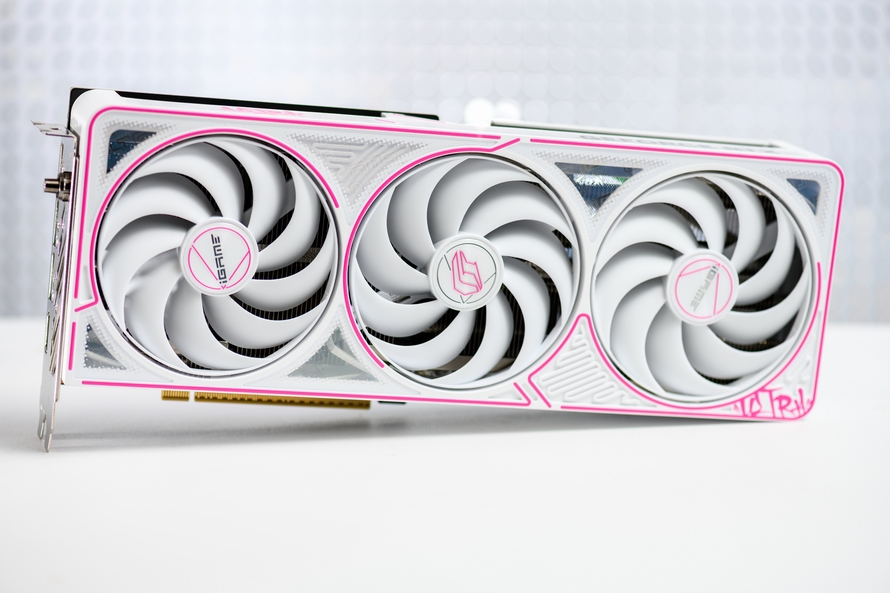
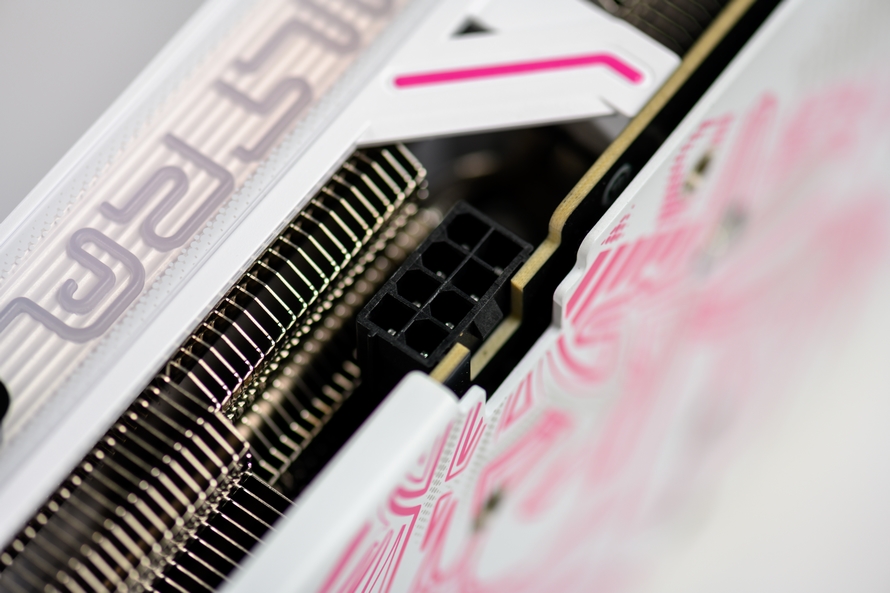
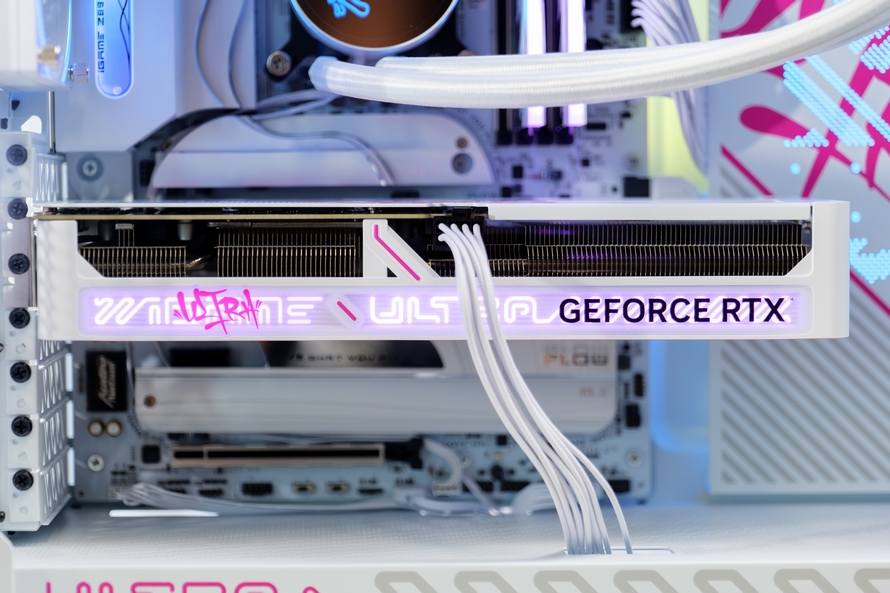
In terms of design, this card abandons the previous "Pop Art" style of the iGame Ultra series and adopts graffiti art from the "Hip-Hop" field as its new logo design language. The graphics card features a white embossed shell adorned with peach pink lines, and uses pixel-style acrylic pieces on the front. An RGB light strip is located below the transparent characters on the side, allowing the entire graphics card to present different lighting effects under the RGB lighting.

It is worth mentioning that perhaps to maintain the integrity of the graffiti characters, Colorful did not hollow out the backplate core bracket of the iGame GeForce RTX 5060 Ti Ultra W OC 16GB, thus enhancing the overall integrity of the graphics card and satisfying the stringent aesthetics of obsessive-compulsive gamers.
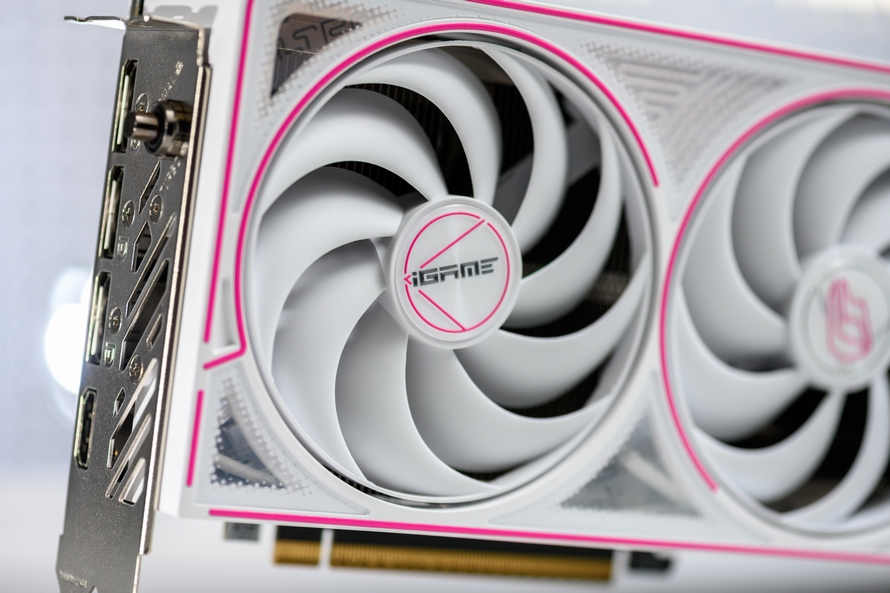

In terms of cooling, the iGame GeForce RTX 5060 Ti Ultra W OC 16GB features 3*90mm ring fans with three laser iGame logos at the center of the blades. Underneath the graphics card shell is a large cooling module with 4 nickel-plated 6mm heat pipes and several nickel-plated fins, which uses reflow soldering technology to dissipate waste heat more quickly.
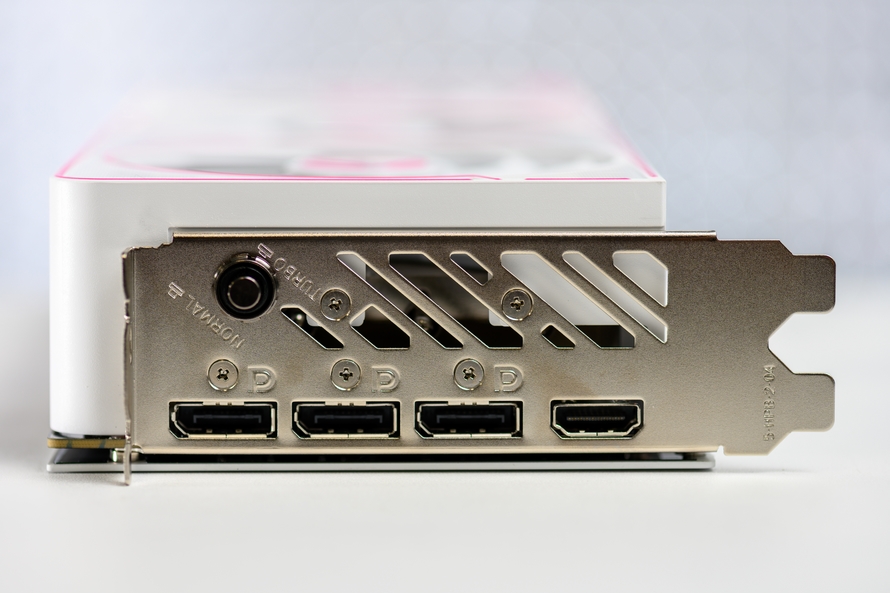
In terms of interfaces, the iGame GeForce RTX 5060 Ti Ultra W OC 16GB has 3 DisplayPort 2.1b interfaces and 1 HDMI 2.1b interface, supporting up to 4K@480Hz or 8K@165Hz. Additionally, Colorful's traditional one-click overclocking button can easily increase the peak core frequency of the graphics card from 2572MHz to 2632MHz.
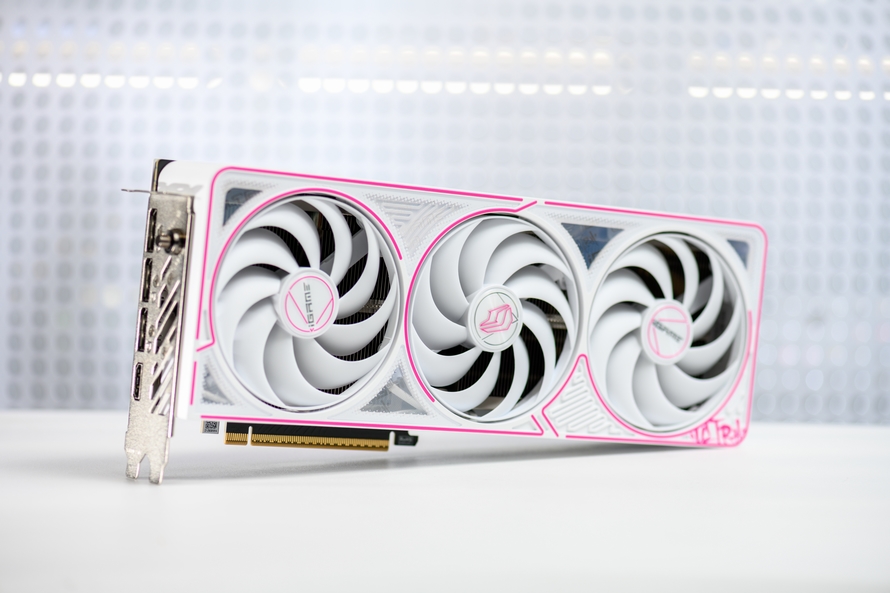
In terms of dimensions, excluding the backplate and bracket, the card measures approximately 300.5mm in length, 120mm in height, and 2.5 slots (50mm) in thickness. It offers excellent cooling while maintaining a relatively compact size, compatible with most ATX cases.
Architecture Analysis
The characteristics of the Blackwell architecture have been discussed extensively. According to NVIDIA, Moore's Law can no longer satisfy the gaming industry and gamers' pursuit of image quality. To further enhance performance while maximizing hardware capabilities, NVIDIA has introduced neural network rendering technology into graphics cards.

To better adapt the graphics card to AI algorithms, NVIDIA has adopted a new SM multi-streaming processor and hardware-based Flip Metering technology in the Blackwell architecture. The fifth-generation Tensor Core also supports FP4 floating-point precision, enabling the generation of more frames with lower hardware consumption.
In terms of ray tracing performance, the Blackwell architecture is more efficient in detecting scenes involving light, paths, and triangle intersections, offering a 1x improvement over the Ada Lovelace architecture and a 7x improvement over the original Turing architecture. It also reduces memory usage and hardware resource consumption.
For graphics memory, consumer-grade graphics cards based on the Blackwell architecture have adopted the latest GDDR7 memory. GDDR7 memory uses PAM3 signal encoding, which is more efficient in data transmission and more power-efficient.
While these technologies may not seem intuitive, their practical application is evident in DLSS 4, particularly the multi-frame generation exclusive to the RTX 50 series.
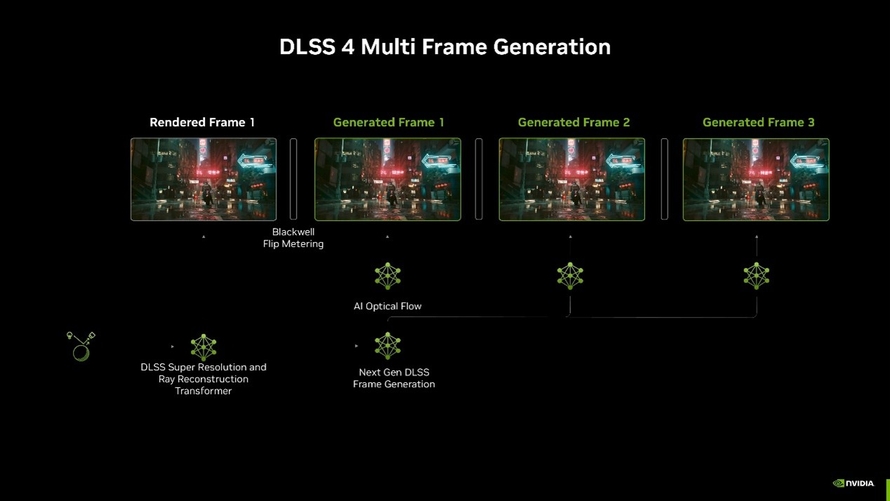
DLSS 4 is a comprehensive technology concept that includes frame generation, light reconstruction, deep learning super-sampling, deep learning anti-aliasing, and other technologies. The multi-frame generation technology brought by DLSS 4 is almost revolutionary. Unlike RTX 40 series graphics cards that interpolate one frame between two frames using hardware optical flow accelerators, RTX 50 series graphics cards interpolate three frames between two frames using AI models, and replace CNN models with Transformer models, achieving a comprehensive improvement in frame rate and image quality.

As one Bilibili UP said, in frame generation technology, the gap between DLSS 4 and Lossless Scaling is akin to that between the Tiangong Space Station and the Mariana Trench.
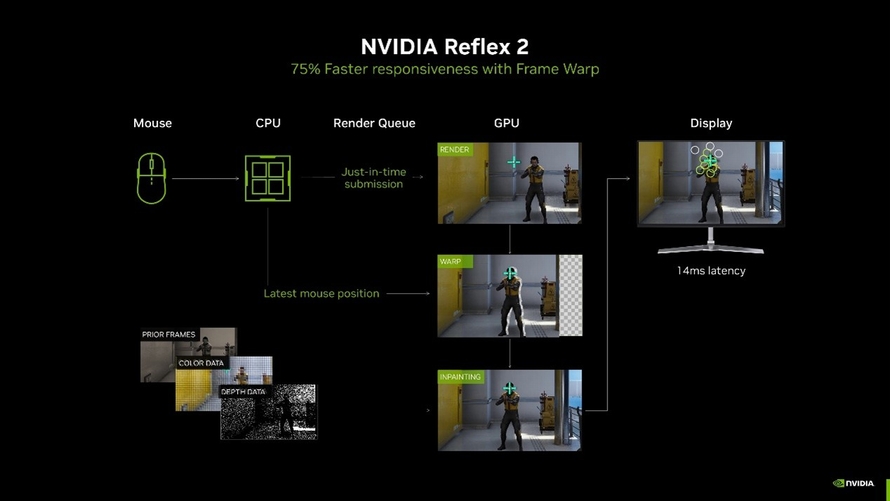
Furthermore, to minimize the operational latency caused by multi-frame generation technology, NVIDIA has introduced NVIDIA Reflex 2 technology, which features Frame Warp frame distortion technology. By distorting frames to reflect the latest mouse position, it enhances the response speed of mouse and camera movements in first-person and third-person games.

For video creators, the most practical features are the ninth-generation NVENC and sixth-generation NVDEC codecs. NVIDIA has introduced hardware codec support for 10bit/8bit H264/H.265 4:2:2 in consumer-grade graphics cards based on the Blackwell architecture. The latest versions of Premiere Pro and DaVinci Resolve already support these codecs, making the production of 4:2:2 encoded videos more efficient.
Test Platform Introduction
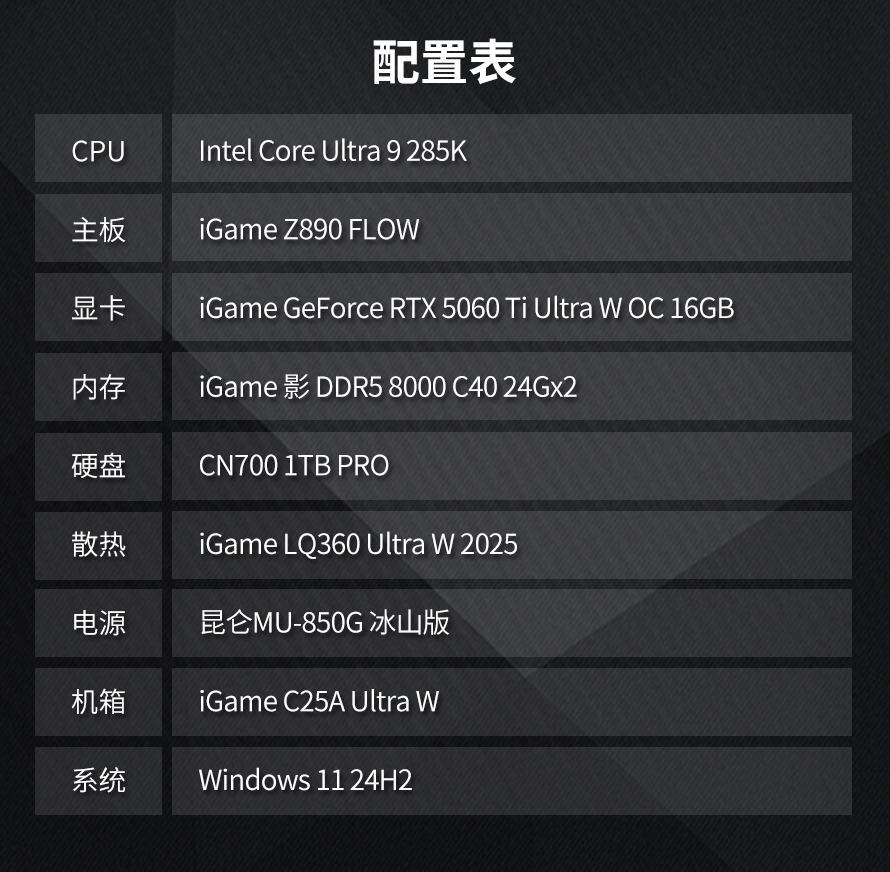
The test platform uses a full Colorful setup. To fully utilize the performance of the iGame GeForce RTX 5060 Ti Ultra W OC 16GB, the CPU selected is Intel's most powerful Core Ultra 9 285K. The chassis and power supply are the iGame C25A Ultra W and Kunlun MU-850G Iceberg Edition, respectively, with a pink and white theme that perfectly matches the build theme. The iGame C25A Ultra W chassis features an Ultra RGB front panel and an Ultra-patterned cable cover, simplifying cable management and enhancing the overall aesthetics. The Kunlun MU-850G Iceberg Edition power supply, with its white modular cables, blends seamlessly into the setup.

The motherboard used is the iGame Z890 FLOW, which features a white base, large aluminum alloy heatsinks, and a glossy chamfered finish, giving it a refined look.

The memory selected is the iGame Phantom DDR5 8000 C40 24Gx2 kit, also featuring a white theme with Chinese ink painting illustrations. It offers powerful performance with a frequency of up to 8000MT/s.
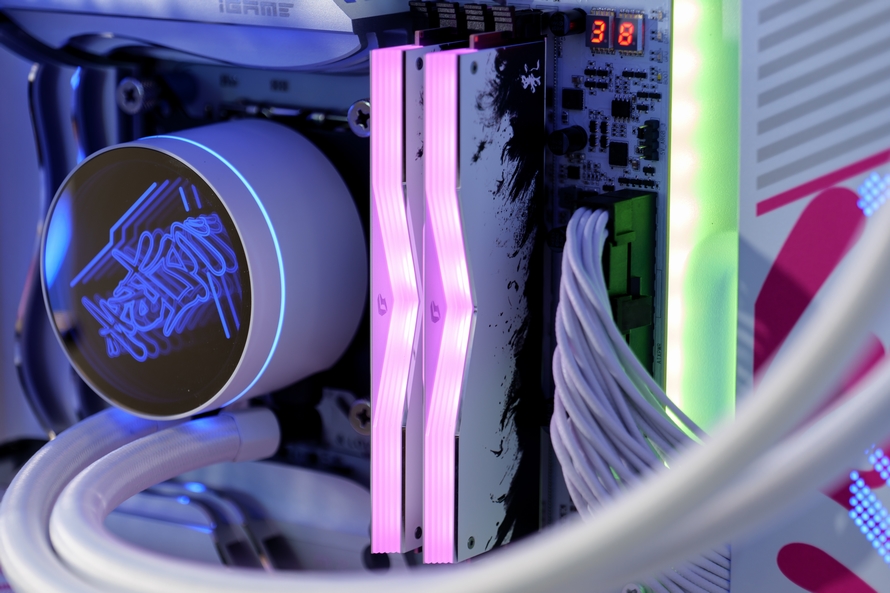
For cooling, the iGame LQ360 Ultra W 2025 all-in-one water cooler is used, featuring an infinite mirror design cold plate and Ultra pattern. The radiator is equipped with 3 RGB fans adorned with unique pink lines from the Ultra W series, making it a perfect match for the iGame GeForce RTX 5060 Ti Ultra W OC 16GB and easily keeping the Intel Core Ultra 9 285K processor cool.
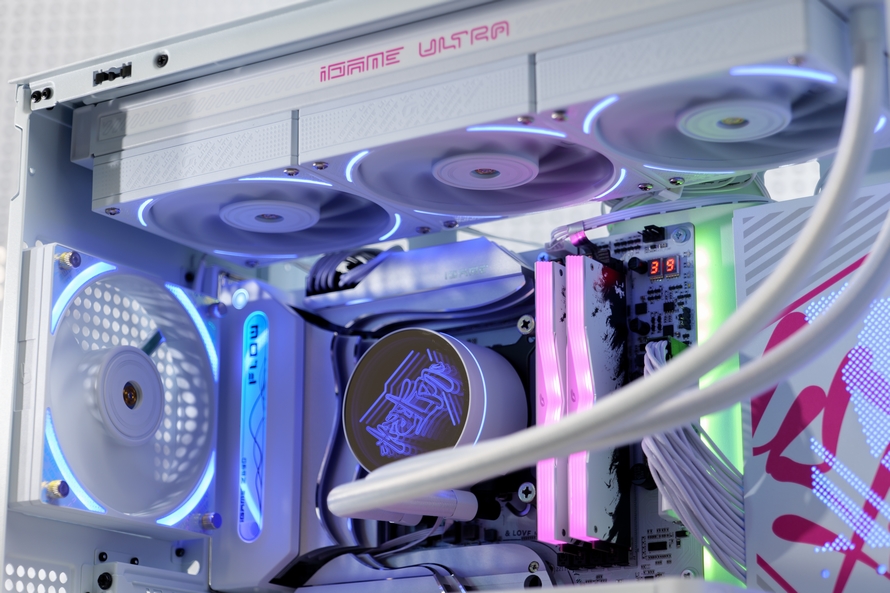
Theoretical Performance Testing
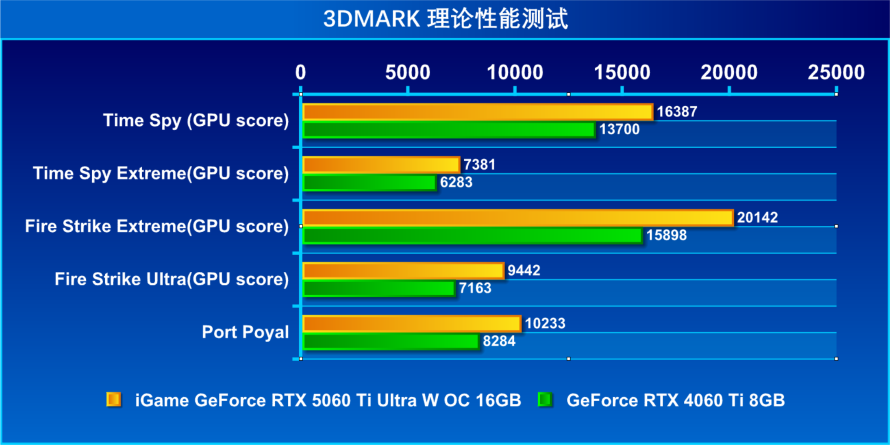
In the 3Dmark benchmarks, the iGame GeForce RTX 5060 Ti Ultra W OC 16GB outperforms the RTX 4060 Ti 8GB by approximately 20% and 17% in the Time Spy and Time Spy Extreme DirectX 12 tests, respectively, and by about 17% in the Port Royal ray tracing test.
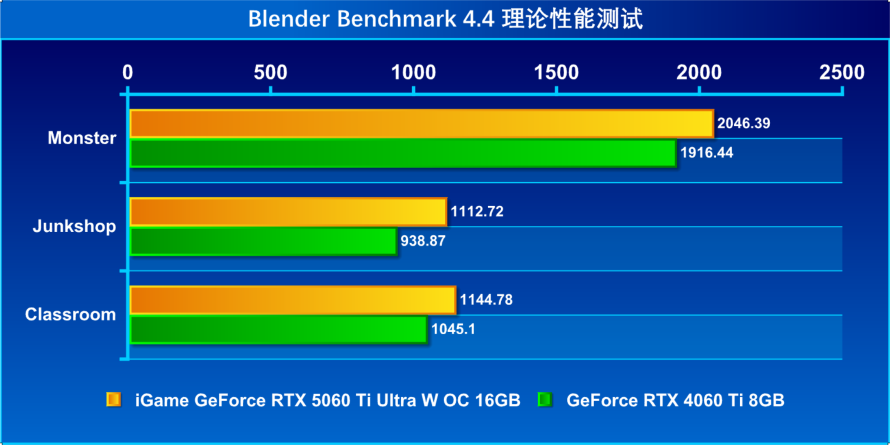
In the Blender Benchmark 4.4's three 3D rendering tests (Monster, Junkshop, Classroom), the iGame GeForce RTX 5060 Ti Ultra W OC 16GB outperforms the RTX 4060 Ti 8GB by approximately 6.7%, 18.5%, and 9.5%, respectively.

In the V-Ray RTX test, the iGame GeForce RTX 5060 Ti Ultra W OC 16GB outperforms the RTX 4060 Ti 8GB by approximately 30%.
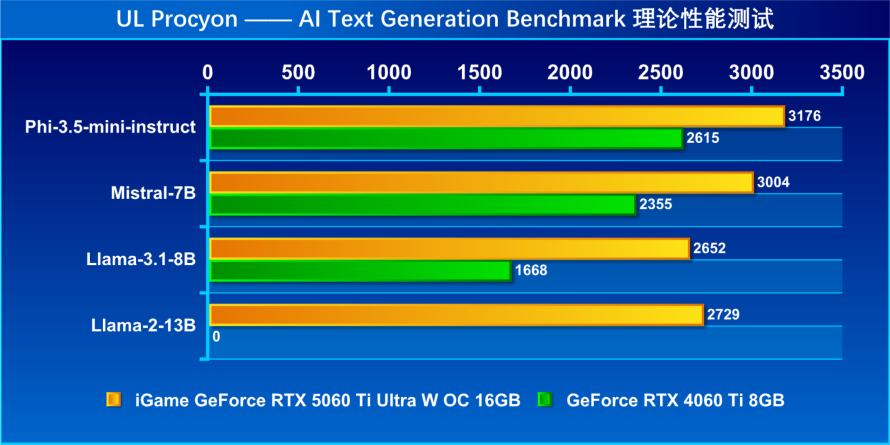

Due to the adoption of 16GB GDDR7 memory by the iGame GeForce RTX 5060 Ti Ultra W OC 16GB, it facilitates the deployment of local AI models of small and medium sizes. Therefore, Hotspot Technology used UL Procyon software to conduct text generation and image generation tests.
The test results indicate that the iGame GeForce RTX 5060 Ti Ultra W OC 16GB outperforms the RTX 4060 Ti 8GB by approximately 21.4%, 27.5%, and 58.9% in projects such as Phi-3.5-mini-instruct, Mistral-7B, and Llama-3.1-8B, respectively. In the case of Llama-2-13B, the RTX 4060 Ti 8GB is unable to run the test at all due to its mere 8GB of VRAM.
Gaming Performance Tests
For gaming tests, a total of five games supporting DLSS 4 were tested, namely "Black Myth: Wukong", "Hogwarts Legacy", "Marvel Snap", "Cyberpunk 2077", and "Alan Wake 2", along with two representatives of traditional rasterized games, "Tomb Raider: Shadow of the Tomb Raider" and "CS:GO". Unless otherwise specified, the graphics quality is set to maximum, with ray tracing enabled (if supported), DLSS Quality mode oversampling at 75% (if supported), and frame rates are reported as averages.
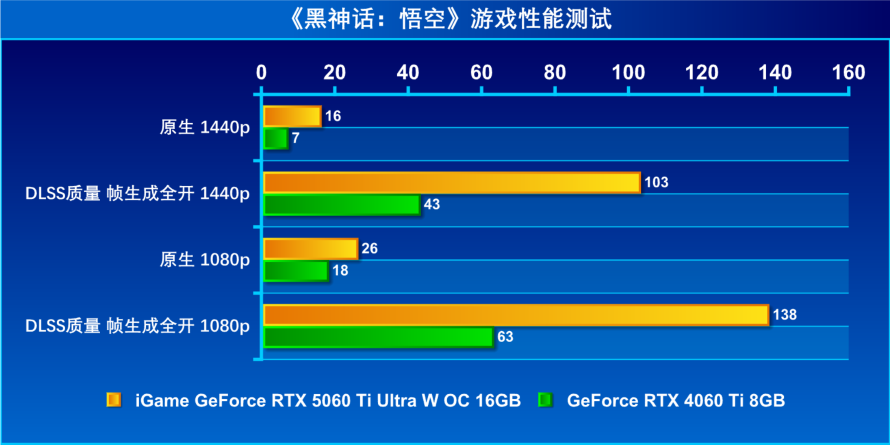
Perhaps to coincide with the first sale of the RTX 5060 Ti, "Black Myth: Wukong" released a new version update yesterday afternoon, adding support for DLSS 4. Therefore, Hotspot Technology had the opportunity to explore the performance of the RTX 5060 Ti on this graphics card killer, "Black Myth: Wukong".
To fully utilize the RTX 5060 Ti's performance, the graphics quality for this test is set to cinematic level, with path tracing enabled and DLSS sampling rate set to 75%.
The results are somewhat shocking. Although the RTX 5060 Ti is predictably not going to shine under native graphics quality, after enabling DLSS Quality mode and 4x frame generation, the frame rate soars to 103 fps (at 1440p). On the other hand, the RTX 4060 Ti may suffer from VRAM overflow, resulting in a single-digit native frame rate, and even after enabling 2x frame generation, it fails to reach the passing mark of 60 fps. With the support of DLSS 4 multi-frame generation, "Black Myth: Wukong" instantly transforms from a slideshow into an esports game, demonstrating the power of 4x frame generation.

Moving on to another DLSS 4 game, "Hogwarts Legacy", the gap between the two cards here is more reasonable compared to the VRAM overflow seen in "Black Myth: Wukong". At 1440p native graphics quality, the iGame GeForce RTX 5060 Ti Ultra W OC 16GB outperforms the RTX 4060 Ti 8GB by about 21%, and at 1080p native graphics quality, it leads by about 17.6%. With DLSS oversampling and frame generation enabled, and with similar native frame rates, the frame rate difference between the two nearly doubles, essentially highlighting the difference between 2x and 4x frame generation.
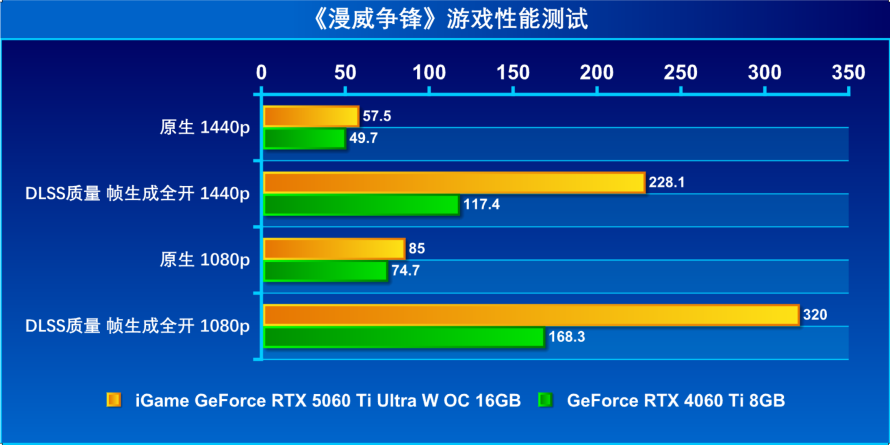
Hotspot Technology also tested the popular online shooter "Marvel Snap". At native graphics quality, whether at 1440p or 1080p, the game is merely playable but not quite up to esports standards. At native 1440p and 1080p, the iGame GeForce RTX 5060 Ti Ultra W OC 16GB outperforms the RTX 4060 Ti 8GB by about 15.7% and 13.8%, respectively. After enabling DLSS Quality mode and frame generation, the frame rates of the iGame GeForce RTX 5060 Ti Ultra W OC 16GB soar to 228.1 fps and 320 fps, while the RTX 4060 Ti 8GB, limited to 2x frame generation, only reaches 117.4 fps and 168.3 fps.

The 3A game "Cyberpunk 2077" is naturally not to be missed. At native 1440p and 1080p, the iGame GeForce RTX 5060 Ti Ultra W OC 16GB outperforms the RTX 4060 Ti 8GB by about 27.5% and 14.8%, respectively. After enabling DLSS Quality mode and frame generation, the gap between the two significantly widens. The RTX 4060 Ti 8GB, possibly limited by its small VRAM capacity, sees no improvement even with 2x frame generation enabled at 1440p, whereas the iGame GeForce RTX 5060 Ti Ultra W OC 16GB achieves an average frame rate of 113.66 fps thanks to its large VRAM and 4x frame generation.

The American horror game "Alan Wake 2" also supports DLSS 4, and Hotspot Technology conducted tests as well. At native 1440p and 1080p, the iGame GeForce RTX 5060 Ti Ultra W OC 16GB outperforms the RTX 4060 Ti 8GB by about 15% and 14%, respectively. After enabling DLSS Quality mode and frame generation, the iGame GeForce RTX 5060 Ti Ultra W OC 16GB leads the RTX 4060 Ti 8GB by about 61% and 57% at 1440p and 1080p, respectively.
Next up are two pure raster performance games, "Tomb Raider: Shadow of the Tomb Raider" and "CS:GO".
Although "Tomb Raider: Shadow of the Tomb Raider" supports the first-generation DLSS, we did not enable this option because both the RTX 5060 Ti and RTX 4060 Ti are capable of running the game at full speed at 1440p and 1080p. For "CS:GO", being an esports game, we enabled the "Winning Graphics" settings, referring to the graphics settings of Bilibili uploader @CCE-CS2.
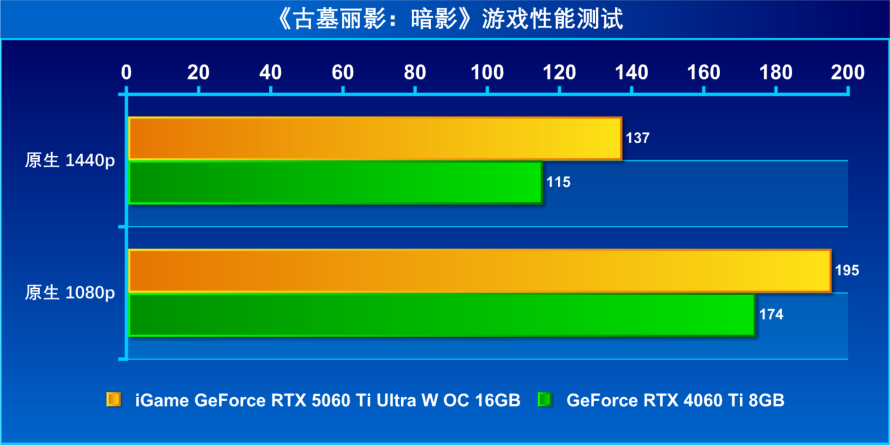
In "Tomb Raider: Shadow of the Tomb Raider" at native 1440p and 1080p, the iGame GeForce RTX 5060 Ti Ultra W OC 16GB outperforms the RTX 4060 Ti 8GB by about 19% and 12%, respectively.
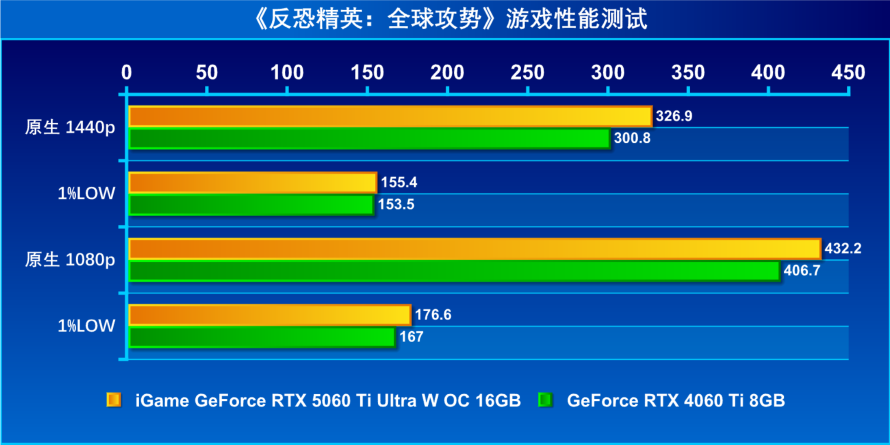
In "CS:GO" at native 1440p and 1080p, the iGame GeForce RTX 5060 Ti Ultra W OC 16GB outperforms the RTX 4060 Ti 8GB by about 8% and 6%, respectively.
Power Consumption and Temperature Tests
In a testing environment with a room temperature of 19°C and the side panel of the chassis open, Hotspot Technology used FurMark to stress test the iGame GeForce RTX 5060 Ti Ultra W OC 16GB graphics card for 1 hour and 24 minutes.
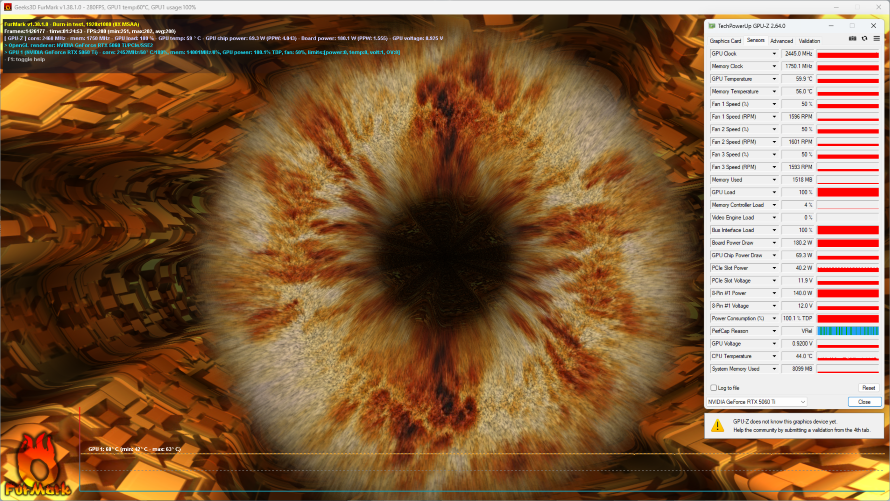
The test results show that the core temperature of the card stabilizes at around 60°C, with the VRAM temperature at only 56°C. At this point, the fan speed is only 1600 RPM, making it almost inaudible. In terms of power consumption, the card draws 40W indirectly from the power supply through the PCIe interface and 140W directly through the 8Pin power supply interface, maintaining a total power consumption of 180W.
Special Features
The iGame GeForce RTX 5060 Ti Ultra W OC 16GB graphics card supports Colorful's official ecosystem control software, iGame Freedom Planet. This software can automatically identify Colorful's computer hardware devices, laptops, peripherals, keyboards, and mice, and can control the lighting of multiple RGB devices in tandem, even linking with desktop dynamic wallpapers, thus avoiding the light pollution dilemma of "you shine yours, I shine mine".
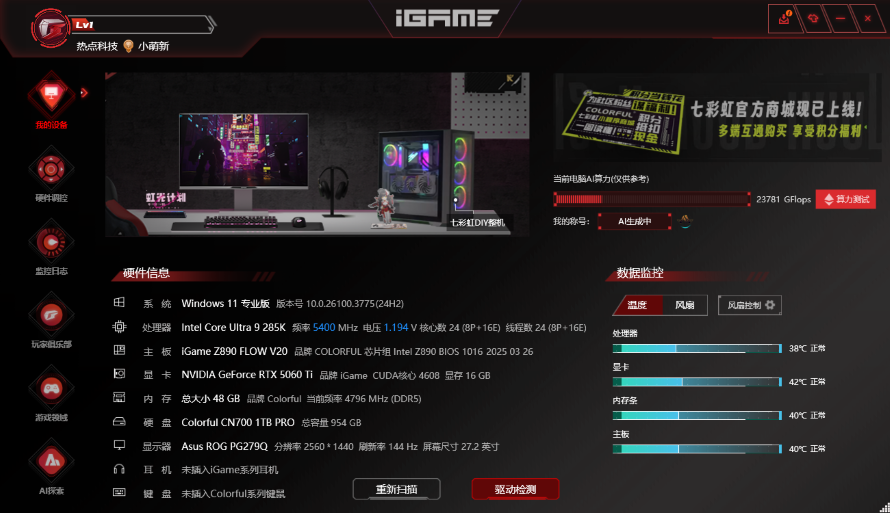


iGame Freedom Planet also comes with a built-in anime AI desktop pet, Qi Xiaoxi, which supports voice interaction. You can use voice commands to ask the desktop pet to perform operations such as overclocking the computer, adjusting lighting, and adjusting fan speed, making traditional human-computer interaction more interesting and user-friendly.
Final Thoughts
With its DLSS 4 technology, NVIDIA's new sweet spot card, the RTX 5060 Ti, can transform originally "cinematic frame rates" into "esports-level frame rates" while maintaining a low power consumption of 180W and a price of just over 3000 yuan. It is foreseeable that this card will be the preferred choice for mainstream gamers building their systems in the next two years.
Colorful's iGame GeForce RTX 5060 Ti Ultra W OC 16GB graphics card, with its unique design, offers a new option for players who prefer a white build style, making it particularly suitable for users who want to assemble a new computer recently and value white aesthetics. In addition, the iGame Ultra Family series products used in this review, whether it's the chassis, graphics card, cooler, motherboard, or memory, all provide robust performance while maintaining a consistent style, demonstrating Colorful's attention to detail and not simply stacking hardware. In terms of software ecosystem, iGame Freedom Planet can easily achieve lighting synchronization across different devices, and through innovative AI desktop pet interaction, makes human-computer interaction more natural and interesting, simplifying previously challenging operations such as overclocking.
Currently, this graphics card is officially available for purchase on Colorful's official online store, Tmall, Pinduoduo, Douyin, and other e-commerce platforms, as well as through authorized retail channels nationwide. Additionally, there are multiple series options such as iGame Advanced and BattleAxe to meet the installation needs of different players in various scenarios. If you're planning to build a computer recently, be sure to check it out!








